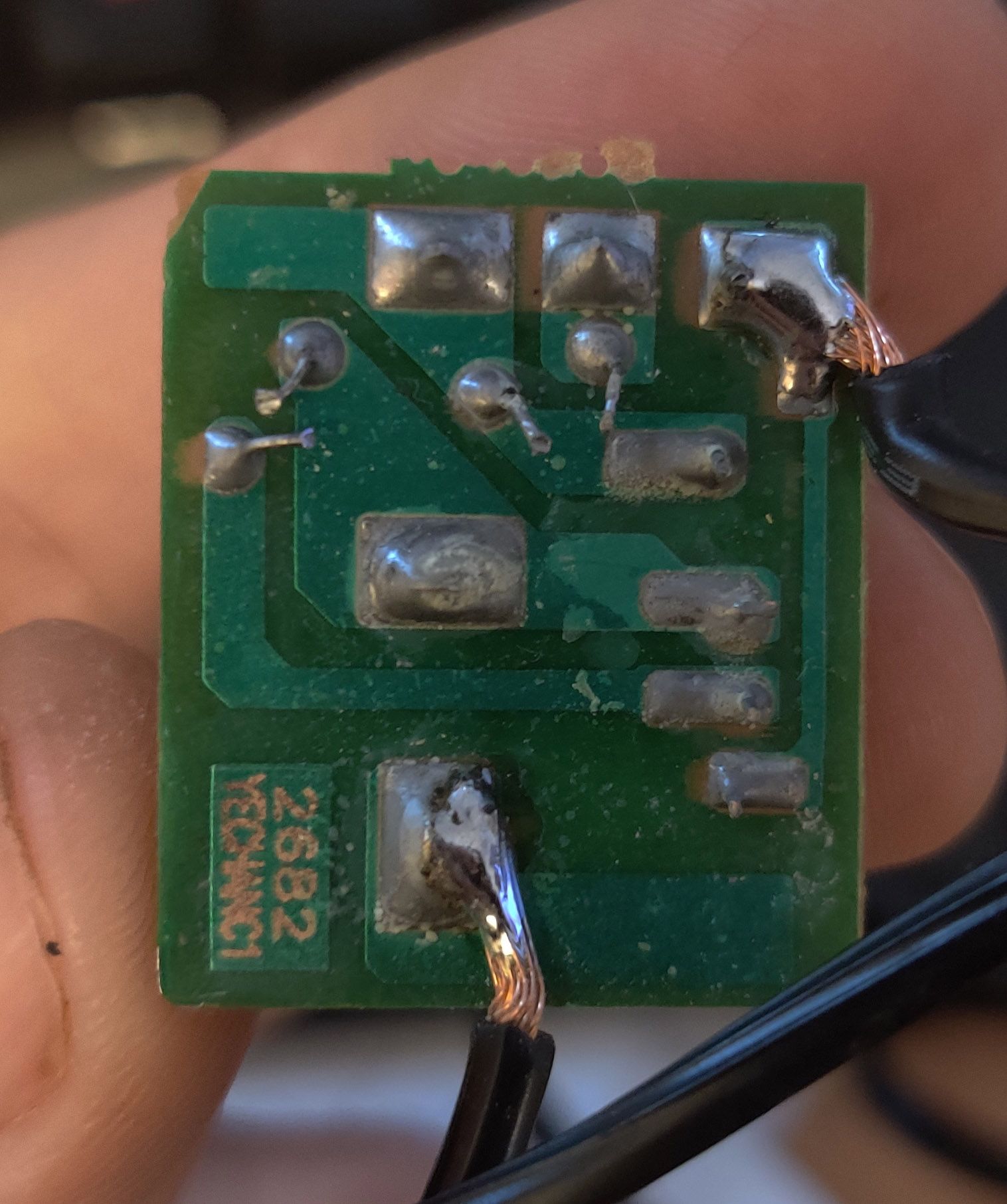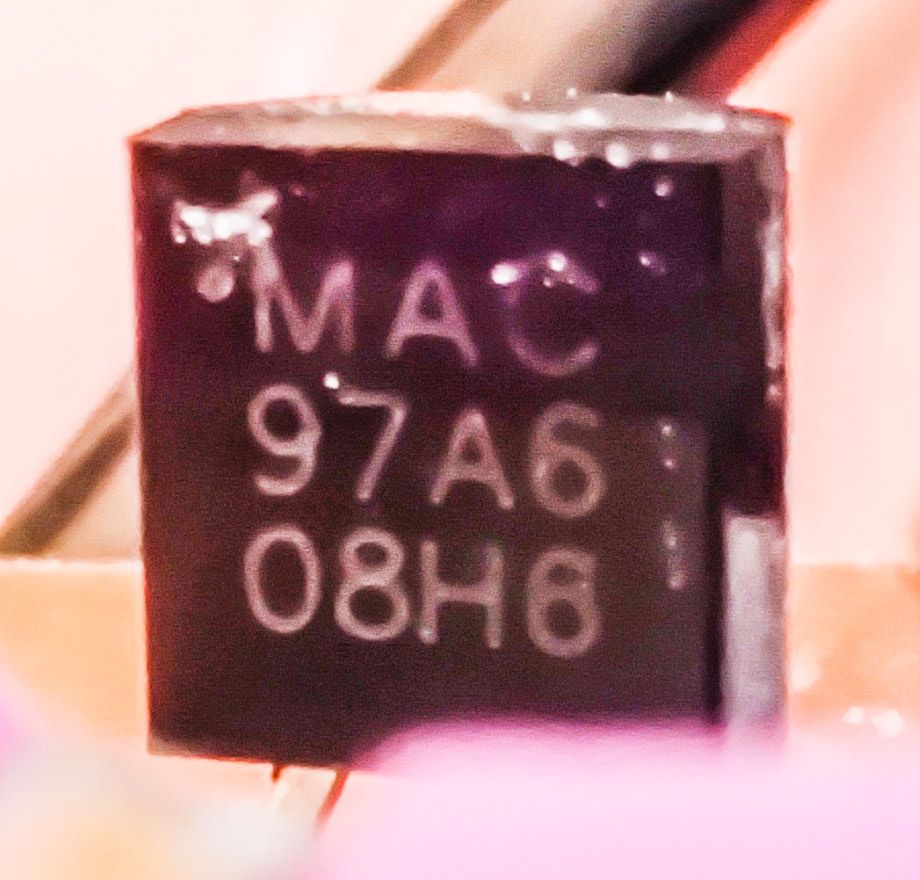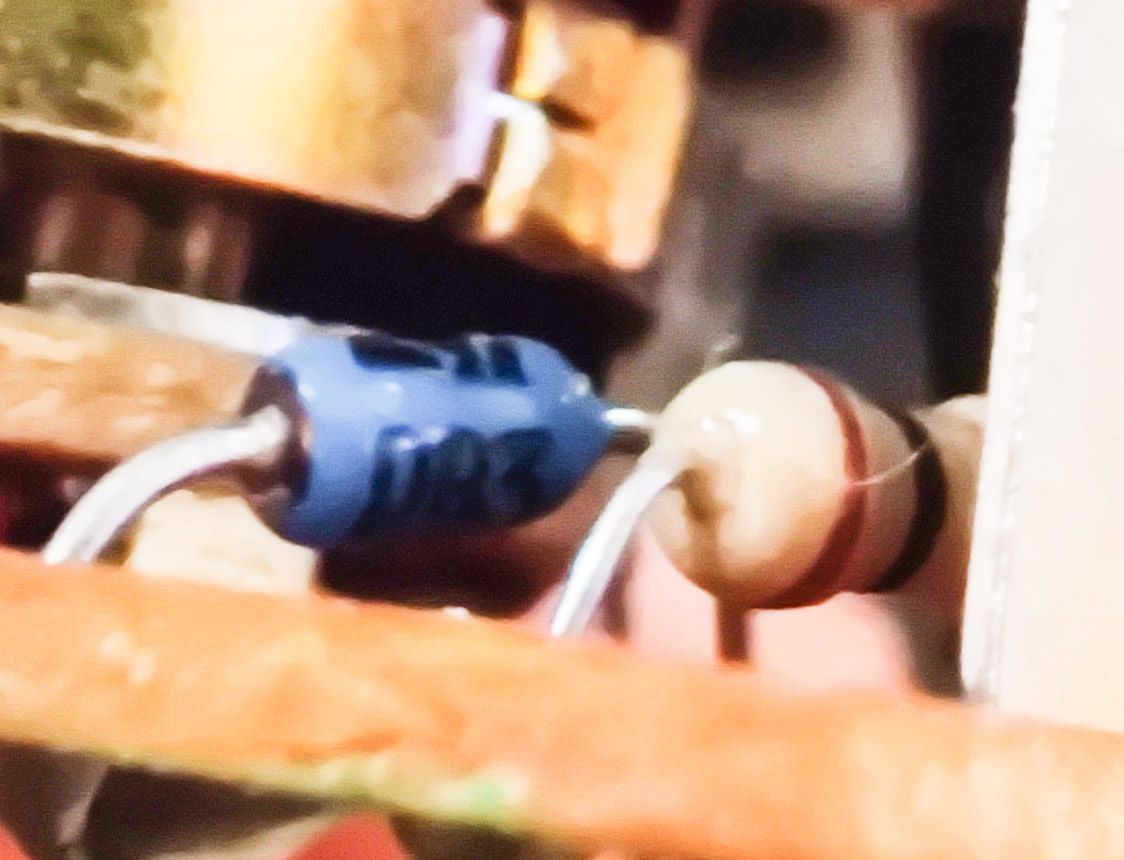How to Control Speed of Small AC Motor
-
-
Great, I can look up that number and see it's a Triac.
That makes sense in this circuit.
It's a common way to "dim" AC loads.I'll see if I can figure out a schematic from the images next.
-
There is a part on the other side of the potentiometer as well as underneath the potentiometer pins.
Gan you get a shot of those parts?
-
I'm having a heck of a time reading the resistor, but I think it's... grey, orange, black, red? I can't measure it properly while it's in the circuit
The blue component appears to say 083
-
The two-pin ST part is probably a Diac. DB3 is close to 083.
That's looking pretty close to a standard phase-based Triac speed control.
(Which is good and bad.)Grey Orange Black Red is 83 Ohms 2%
Red Black Orange SILVER is a 20K Ohm 10% resistor, so that's likely what it is.Let me try and build a schematic.
-
I'm pretty close, but I can't see where the wire that goes to the pump motor connects.
Something underneath the end of the potentiometer that doesn't have pins?
-
Anyway, good news bad news.
It's a pretty standard AC dimmer.
look for "Triac Phase Control" on this page to see the circuit.You've got a potentiometer and a 20K Ohm resistor in series and that's why you have one extra part.
The bad news is that this is a good way to control AC motor power.
Just swapping in an SSR like for a heated bed probably won't make your pump run very well.How about mounting the potentiometer to a model hobby servo and controlling it that way?
Is that reasonable?
-
@alankilian The wire in the top-right corner (picture of the bottom of circuit board) goes to the motor. The wire next to the writing is the load input.
I was wondering if I could solder in a digital potentiometer like this: https://www.sparkfun.com/products/10613
in parallel with the existing pot, just kinda add wires to the existing solder at the pot pins, and have the digital pot be controlled via PWM from the fan header. That way, when the dial is set to off, the board could control it, and when the board isn't controlling it, I could still set its manually with the knob. Would that be workable? -
A digital pot certainly would work as a replacement for the manual pot, but you can't control a digital pot with a PWM signal.
It neds to have specific command sent to it to configure it and adjust it's settings.
-
@alankilian Darn... and I can't find any PWM-controlled potentiometers. Doesn't seem like that's a common use case. I guess I could do a hobby servo to turn the knob. It's not my favorite solution, but I think it would work out pretty well. Do you have any recommendation?
-
How far do you need to turn the knob to get the range of pressures you want?
Most hobby servos can turn 180-degrees.
Most potentiometers turn more than that, so if you can find a 180-degree range of potentiometer angles, you can just bolt on a hobby servo.
Luckily, you have a 3D printer and can just print something up!Then, how do you want to control it from Duet?
GCODE from your slicer or something more automatic? -
@alankilian 270 degrees from completely off, but there's only 180 degrees of actual speed adjustment
It's my part cooling fan. I've been having a lot of trouble with part cooling when printing above 250mm/s. Accuracy is spot-on, but the heat buildup in the part is causing things to get badly warped after a few minutes. My current 6w pump isn't adequate (brushless 24v, runs right from a fan header), so I'm hoping this 20w pump will be more adequate. It certainly spews forth a ton of air.
I've got some old Traxxas steering boxes laying around, though I don't think they can handle much more than 6v. Ideally I could just hook a servo right up to the same 24v fan header and have it behave the same as the old pump. Though I could switch to one of the 5v outputs if absolutely necessary.
-
which board are you connecting it to?
-
@jay_s_uk Duet 3
-
@GoremanX said in How to Control Speed of Small AC Motor:
Ideally I could just hook a servo right up to the same 24v fan header
You are going to have to hook the servo to some source of 5 Volt power and to a nonfan output pin.
THIS page shows how to hook up a hobby servo.
THIS page shows how to control the angle of a hobby servo.
-
@alankilian So if I'm understanding this right, I could power the servo directly from a separate 5v power supply (which I happen to already have in my printer), and then send the pwm signal from one of the IO headers, and not have to worry about protecting the board from damage with diodes?
I have a servo motor here with a 300 degree sweep. Can I set M950 to an io pin rather than an output, and then just have the motor turn from, say, 5 degrees to 295 degrees by just setting the fan speed the same way I would a normal fan? I could just mount the dimmer board to a spring so the entire thing twists when the servo goes beyond the range of the pot. Or is the PWM signal not the same in servo vs fan mode?
-
@GoremanX I have never used a servo, so I'm not going to really be able to help with the controls-side of things.
Don't the links I sent discuss how to control the angle of the servo from GCODE?
-
@alankilian Yeah but angular motion isn't how the firmware controls fan speed. If I want part cooling to work, it looks like the part cooling fan needs to be assigned with M950 and M106, and then assigned to the appropriate tool with M563. I don't know if a servo that was assigned with M42 can be assigned to M563. In any case, M42 basically does the same thing as M106, but with preset frequencies that are appropriate to servos. So it's possible I can just replicate that with M950 Q50
-
Wait... does it even matter what connector I use? Isn't the PWM signal on fan headers generated by the ground pin? Couldn't I just hook up the PWM signal wire of the servo motor to any fan output ground pin? I don't know if the io headers are evn PWM-capable...
-
No, you need a pin that can go high and low to signal the servo.
The fan outputs only go high-impedance to low.
So you COULD tie a resistor to +5 from the fan ground pin and use tht as a signal.
I don't know why that would help you control the servo though.
I just don't know enough about fan control to be able to help.Other than that, I don't know how fan-control can be mapped into servo-angle control.
Maybe searching on the forum will help you come up with something.




